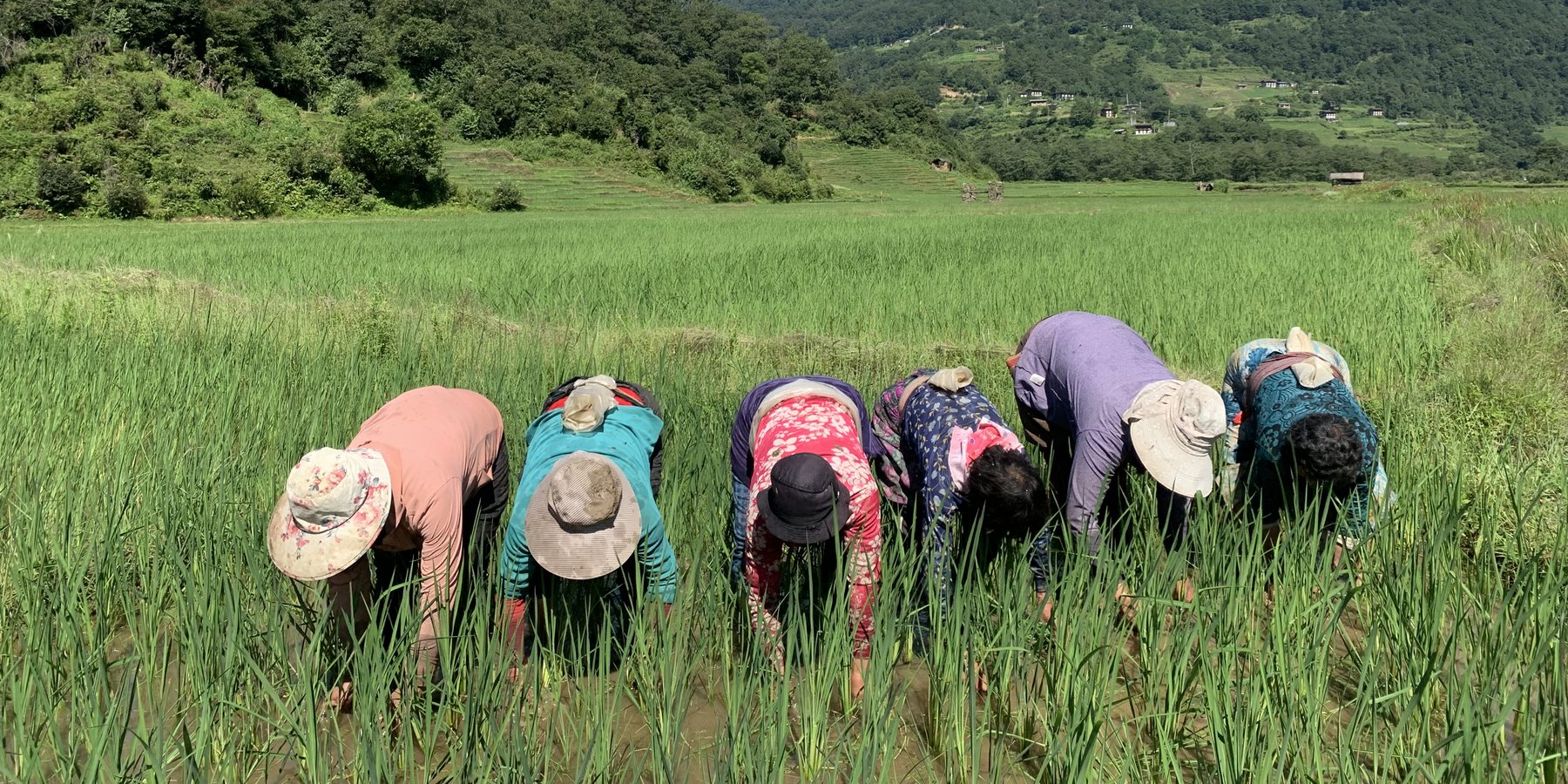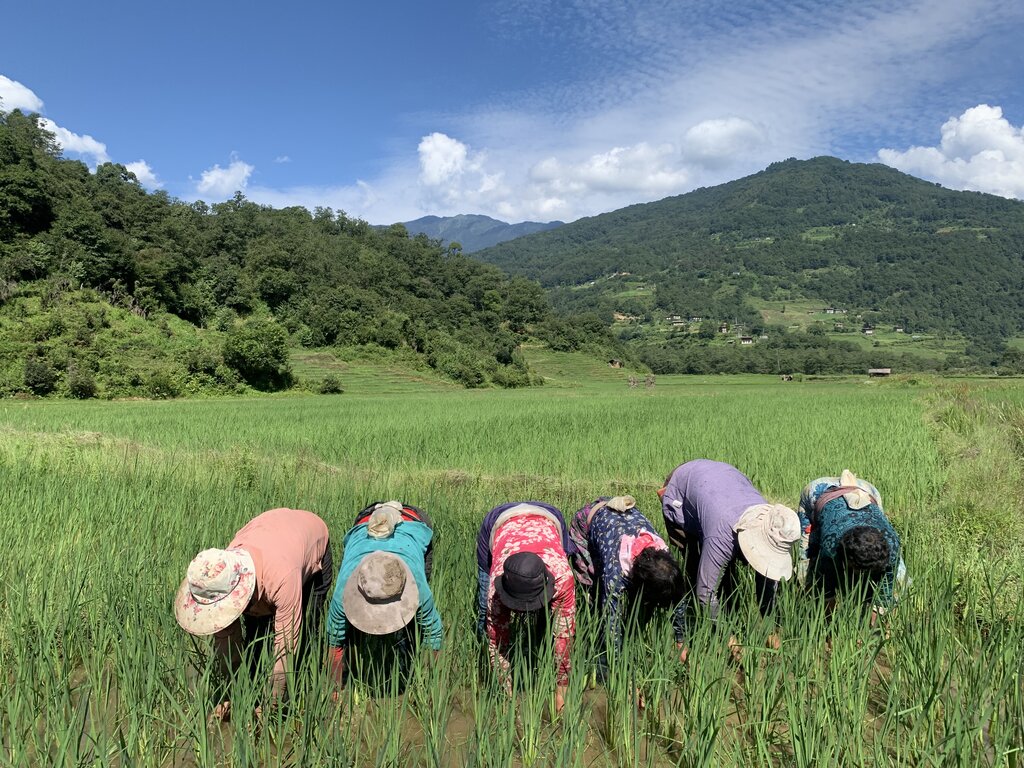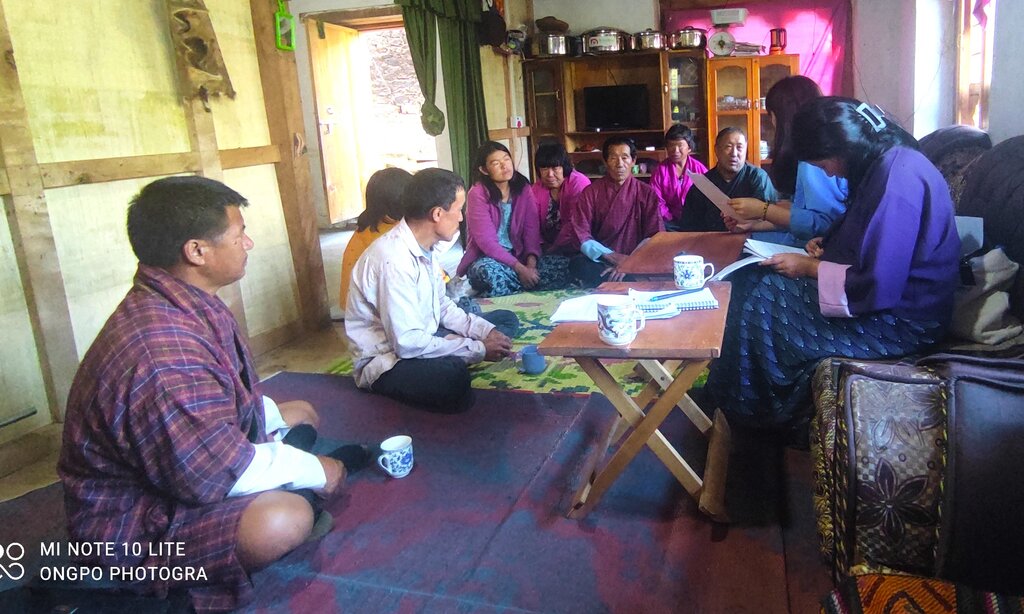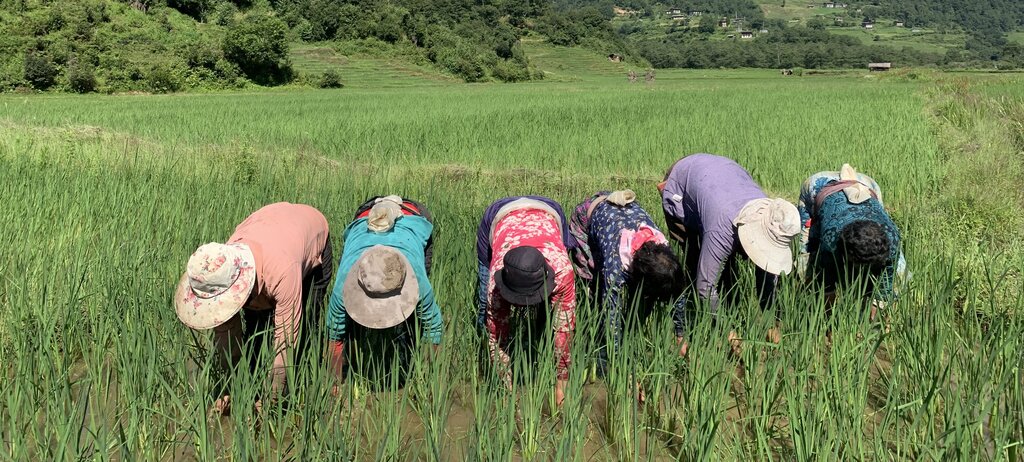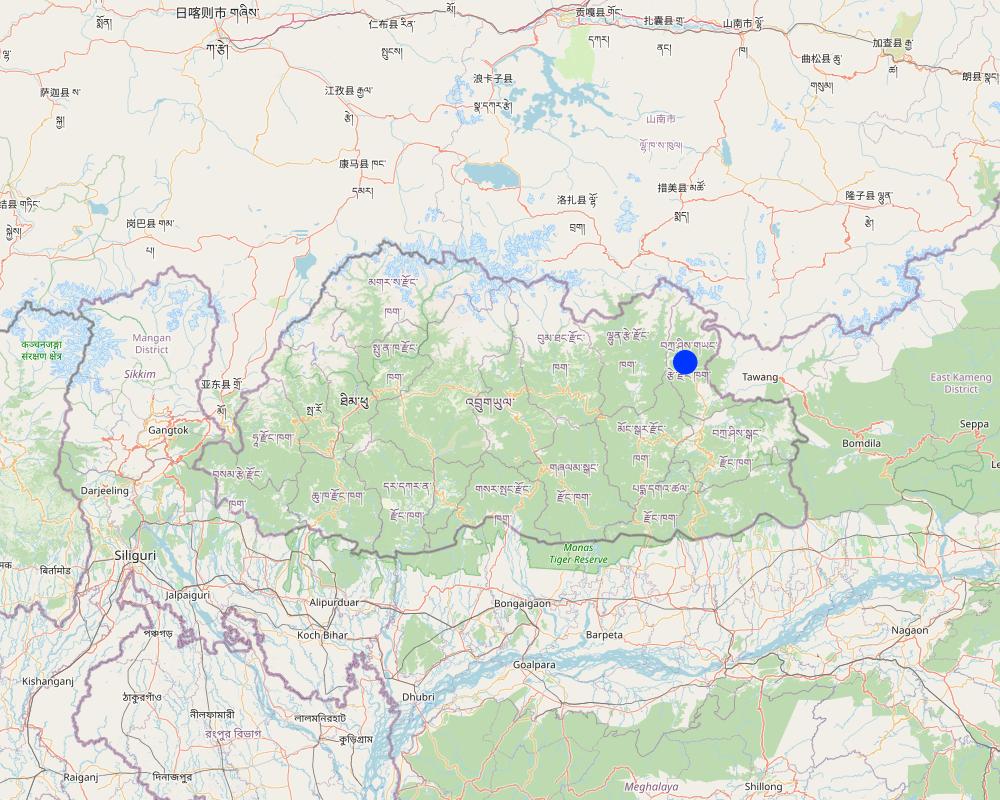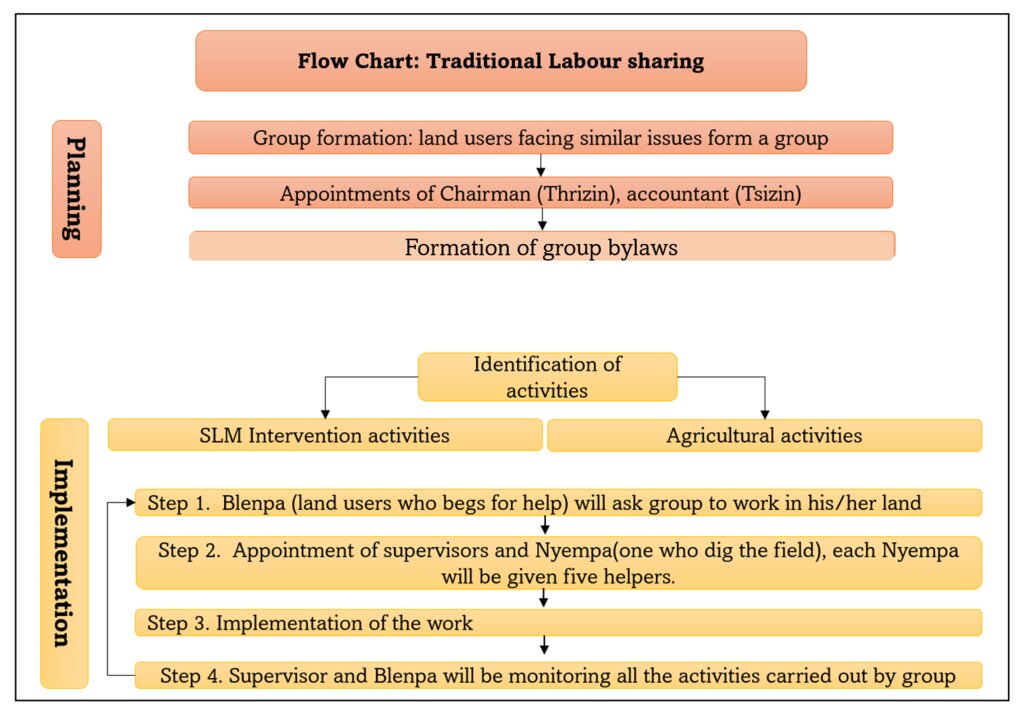Traditional labour sharing for farming [ภูฏาน]
- ผู้สร้างสรรค์:
- การอัพเดท:
- ผู้รวบรวม: ONGPO LEPCHA
- ผู้เรียบเรียง: Tashi Wangdi
- ผู้ตรวจสอบ: William Critchley, Rima Mekdaschi Studer
Latsab
approaches_6894 - ภูฏาน
ดูส่วนย่อย
ขยายทั้งหมด ย่อทั้งหมด1. ข้อมูลทั่วไป
1.2 รายละเอียดที่ติดต่อได้ของผู้รวบรวมและองค์กรที่เกี่ยวข้องในการประเมินและการจัดเตรียมทำเอกสารของแนวทาง
วิทยากรหลัก
ผู้ใช้ที่ดิน:
Geduula
17324491
Namthurang wog, Betsamaang, Bumdeling, Trashi Yangtse District
ภูฏาน
ผู้ใช้ที่ดิน:
Dema Karma
17328742
Namthurang wog, Betsamaang, Bumdeling, Trashi Yangtse District
ภูฏาน
ผู้ใช้ที่ดิน:
Pelden Tshering
17371568
Namthurang wog, Betsamaang, Bumdeling, Trashi Yangtse District
ภูฏาน
ผู้ใช้ที่ดิน:
Tshering Gonpo
17559260
Namthurang wog, Betsamaang, Bumdeling, Trashi Yangtse District
ภูฏาน
ผู้ใช้ที่ดิน:
Wangmo Ugyen
17278903
Namthurang wog, Betsamaang, Bumdeling, Trashi Yangtse District
ภูฏาน
ผู้ใช้ที่ดิน:
Karma
17363810
Namthurang wog, Betsamaang, Bumdeling, Trashi Yangtse District
ภูฏาน
ผู้ใช้ที่ดิน:
Gurula
17718668
Namthurang wog, Betsamaang, Bumdeling, Trashi Yangtse District
ภูฏาน
ผู้ใช้ที่ดิน:
Choden Karma
17781323
Namthurang wog, Betsamaang, Bumdeling, Trashi Yangtse District
ภูฏาน
ผู้ใช้ที่ดิน:
Chozom Sither
17743907
Namthurang wog, Betsamaang, Bumdeling, Trashi Yangtse District
ภูฏาน
ผู้ใช้ที่ดิน:
Gonpo Tshewang
17705121
Namthurang wog, Betsamaang, Bumdeling, Trashi Yangtse District
ภูฏาน
ชื่อของโครงการซึ่งอำนวยความสะดวกในการทำเอกสารหรือการประเมินแนวทาง (ถ้าเกี่ยวข้อง)
Strengthening national-level institutional and professional capacities of country Parties towards enhanced UNCCD monitoring and reporting – GEF 7 EA Umbrella II (GEF 7 UNCCD Enabling Activities_Umbrella II)ชื่อของโครงการซึ่งอำนวยความสะดวกในการทำเอกสารหรือการประเมินแนวทาง (ถ้าเกี่ยวข้อง)
National Soil Services Centre, Department of Agriculture, Ministry of Agriculture & Livestock (NSSC) - ภูฏาน1.3 เงื่อนไขที่เกี่ยวข้องกับการใช้ข้อมูลที่ได้บันทึกไว้ผ่านทาง WOCAT
วันที่เก็บรวบรวมข้อมูล (ภาคสนาม):
20/7/2023
ผู้รวบรวมและวิทยากรหลักยอมรับเงื่อนไขเกี่ยวกับการใช้ข้อมูลที่ถูกบันทึกผ่านทาง WOCAT:
ใช่
2. คำอธิบายของแนวทาง SLM
2.1 การอธิบายแบบสั้น ๆ ของแนวทาง
In the past, it was difficult for households to complete seasonal farming activities like ploughing, sowing, and transplanting in time. So, land users came together by adopting 'latsab' or labour sharing. This involves pooling land users, who work on a rotational basis on the plots of the different group members. Labour sharing is a very old approach but is still being practiced throughout the country.
2.2 การอธิบายอย่างละเอียดของแนวทาง
การอธิบายอย่างละเอียดของแนวทาง:
In the past, it was difficult for households to complete seasonal farming activities like ploughing, sowing, and transplanting in time. So, land users came together by adopting 'latsab' or labour sharing. This involves pooling land users, who work on a rotational basis on the plots of the different group members. Labour sharing is a very old approach but is still being practiced throughout the country. In addition, land users also come together for any construction work or other activities related to land management. Labour sharing aims to complete seasonal farming activities more efficiently and on time. The approach also helps economically disadvantaged land users who cannot pay wages to employ. Other co-benefits reported are the improved sense of community and enhanced social cohesion because the exchange of experiences and collaboration builds mutual trust. Working in a group eases hard physical work, such as carrying and breaking large boulders, and is perceived to be much more enjoyable than working alone or in a household setting.
Groups are formed at the village and sub-village levels to enable households to take up labour-intensive SLM activities, such as stone bunding, bench terracing, stone check dam construction, water source protection works, or grass hedgerow development. Labour-sharing involves land users coming together to discuss important agricultural activities to be implemented. They also select the land users where the work should start. When it comes to activities related to SLM intervention, the land users are given initial practical training on the SLM intervention, which starts with hands-on work on the land of a group member, preferably that of a vulnerable household. Labour-sharing groups, therefore, facilitate the inclusion of vulnerable households, especially female-headed and small families, in the implementation of labour-intensive SLM interventions. In addition to technical guidance provided by extension staff, support is given to the group formation process, such as drafting informal by-laws and group management.
Any activities through a labour-sharing approach have to undergo specific stages. Initially, the land users will come together to discuss important agricultural or SLM activities to be carried out in a season. Secondly, they identify a 'Blenpa' who is a land user who requests help on his/ her land. Once in the field before they start any activities a supervisor or 'la pon' is appointed. If work involves heavy digging, a 'Nyempa' (preferably a strong man) is appointed, and he will be assisted by four or five women. The labour-sharing group is formed through common interests among different land users in the community. The group members come together and plan and prepare by-laws. They appoint a chairman or 'Trizin', who is the overall manager of the group. The accountant/treasurer or 'Tsezin' is appointed to take care of the finances. Any conflict between land users is solved within the group.
2.3 รูปภาพของแนวทาง
2.5 ประเทศ ภูมิภาค หรือสถานที่ตั้งที่ได้นำแนวทางไปใช้
ประเทศ:
ภูฏาน
ภูมิภาค/รัฐ/จังหวัด: :
Namthrang wog (sub village), Betsamaang(village), Bumdeling(region), Trashi Yangtse(Provience)
Map
×2.6 วันที่เริ่มต้นและสิ้นสุดของแนวทาง
ถ้าไม่รู้ปีที่แน่นอนให้ประมาณวันที่ที่ริเริ่มใช้แนวทางนี้ :
มากกว่า 50 ปี (แบบดั้งเดิม)
ความคิดเห็น:
The exact date and year of initiation are not known as this approach has been practiced by their ancestors.
2.7 ประเภทของแนวทาง
- แบบดั้งเดิม/ แบบพื้นเมิอง
2.8 เป้าหมายหรือวัตถุประสงค์หลักของแนวทาง
The main aims/objectives of the approach are 1) Labour-sharing to complete seasonal activities faster and on time, 2) To support economically disabled land users who cannot pay for hired workers, and 3) To share resources like water which is important for carrying out farming activities.
2.9 เงื่อนไขที่เอื้ออำนวยหรือเป็นอุปสรรคต่อการนำเทคโนโลยีภายใต้แนวทางนี้ไปปฏิบัติใช้
บรรทัดฐานและค่านิยมทางสังคม วัฒนธรรม ศาสนา
- เอื้ออำนวย
All land users involved are from same ethnic group. They shared common social, cultural, and religious, norms and values. Implementation of any SLM activities was seen as enabling.
การมีไว้ให้หรือการเข้าถึงแหล่งการเงินและบริการ
- เอื้ออำนวย
Land users were accessible to financial resources and services as most of them are either members of a vegetable group or a Chilli group. As a member, they are privileged to avail loans.
การร่วมมือหรือการทำงานประสานกันของผู้ลงมือปฏิบัติ
- เอื้ออำนวย
The group formation is democratic and the leader selected to regulate the group was selected by land users themselves. Therefore, strong collaboration is observed.
ความรู้เกี่ยวกับ SLM การเข้าถึงการสนับสนุนด้านเทคนิค
- เอื้ออำนวย
Land users are aware of SLM interventions like terracing, bunding, stone bunding, growing Napier grass, etc. These indicated that they have good knowledge and are accessible to technical support from SLM specialists.
ตลาด (จัดซื้อปัจจัยนำเข้า ขายผลิตภัณฑ์) และราคา
- เอื้ออำนวย
Land users indicated that they have a good market for their produce like chilli and potatoes. They have a group that deals with marketing.
ปริมาณงานที่ทำได้ กำลังคนที่มีให้
- เอื้ออำนวย
Land users are happy that the current approach of labour-sharing helped them a lot when it comes to workload and labour shortage. Although if there are fewer household members, the approach helps them to carry out important agricultural activities in time.
3. การมีส่วนร่วมและบทบาทของผู้มีส่วนได้ส่วนเสียที่เกี่ยวข้อง
3.1 ผู้มีส่วนได้ส่วนเสียที่เกี่ยวข้องในแนวทางนี้และบทบาท
- ผู้ใช้ที่ดินระดับท้องถิ่นหรือชุมชนระดับท้องถิ่น
10 households were involved out of which 6 are females and 4 are male. They are mostly from the age group between 40-60 years old, All of them are married and are economically disabled. All of them belong to the same ethnic group known as
Land users are involved in the planning of by-laws, and implementation of activities, Elected chairman is responsible for the smooth functioning of the group. The accountant takes care of the finances. Any conflict between land users is solved within the group.
- ผู้เชี่ยวชาญ SLM หรือที่ปรึกษาการเกษตร
Extension agent
He/she is not part of the group but is involved whenever he/she needs assistance from the group. He/she acts as an SLM specialist at the village level.
3.2 การเกี่ยวข้องของผู้ใช้ที่ดินระดับท้องถิ่นหรือชุมชนระดับท้องถิ่นในช่วงต่างๆของแนวทาง
| ความเกี่ยวข้องของผู้ใช้ที่ดินระดับท้องถิ่นหรือชุมชนระดับท้องถิ่น | ระบุผู้ที่มีส่วนเกี่ยวข้องและอธิบายกิจกรรม | |
|---|---|---|
| การริเริ่มหรือการจูงใจ | ระดมกำลังด้วยตนเอง | The labour-sharing approach was initiated by the ancestors of current land users. Current land users found this approach as an effective way to mitigate labour shortage and resource management and they continue to preserve and practice it. |
| การวางแผน | ระดมกำลังด้วยตนเอง | Land users are the ones who come together, prepare their by-laws and plan all the activities related to farming or SLM intervention. |
| การดำเนินการ | ระดมกำลังด้วยตนเอง | The approach has an elected chairman and accountant who are responsible for the smooth running of the group and finances. Any conflicts that arise between land users are solved within the group. |
| การติดตามตรวจสอบหรือการประเมินผล | ระดมกำลังด้วยตนเอง | The group is monitored by the chairman. During the time of any activities, they also appoint a supervisor who will monitor the quality of the work performed by the members. |
3.3 แผนผังแสดงขั้นตอนการทำงาน (ถ้ามี)
คำอธิบาย:
Flow chart created following conversation with the group. There are two important phases, initially planning which includes group formation, and by-law, and the second phase is the implementation phase.
ผู้เขียน:
Ongpo Lepcha
3.4 การตัดสินใจเลือกใช้เทคโนโลยี SLM
ระบุผู้ที่ทำการตัดสินใจเลือกเทคโนโลยีมากกว่าหนึ่งวิธีไปปฏิบัติใช้:
- ผู้ใช้ที่ดินเป็นผู้ตัดสินใจหลัก โดยการสนับสนุนจากผู้เชี่ยวชาญ SLM
การอธิบาย:
The technologies implemented by land users have been decided by land users and upon their request to the government the SLM specialist are sent and technology related training and materials are provided to the group.
4. การสนับสนุนด้านเทคนิค การสร้างขีดความสามารถ และการจัดการด้านความรู้
4.1 การสร้างขีดความสามารถ / การอบรม
ได้มีการจัดอบรมให้แก่ผู้ใช้ที่ดินหรือผู้มีส่วนได้ส่วนเสียคนอื่น ๆ หรือไม่:
ใช่
ให้ระบุว่าใครเป็นผู้ได้รับการอบรม:
- ผู้ใช้ที่ดิน
รูปแบบการอบรม:
- ใช้พื้นที่ทำการสาธิต
หัวข้อที่พูด:
Improved ways to dry Chilli, Nursery bed preparation, electric fencing, Growing Napier grass, Chainlink fencing, Greenhouse construction, etc.,
ความคิดเห็น:
The training was provided by extension agents
4.2 การบริการให้คำแนะนำ
ผู้ใช้ที่ดินมีการเข้าถึงการรับบริการให้คำปรึกษาหรือไม่:
ใช่
การอธิบาย/แสดงความคิดเห็น:
Whenever there is an outbreak of crops or livestock diseases, advisory services are provided by agricultural and livestock officers on do and don't of the issues.
4.3 การเสริมความแข็งแกร่งให้กับสถาบัน (การพัฒนาองค์กร)
สถาบันได้รับการจัดตั้งขึ้นมาหรือเสริมความแข็งแกร่งโดยแนวทางนี้หรือไม่:
- ใช่ อย่างมาก
ระบุระดับของสถาบันที่ได้รับการเสริมความแข็งแกร่งหรือจัดตั้งขึ้นมา:
- ท้องถิ่น
อธิบายถึงสถาบัน บทบาทและความรับผิดชอบ สมาชิก เป็นต้น:
Within the labour-sharing group, land users also have formed other groups like the Chilli group (focusing on cultivating and marketing chilli), Vegetable group (involved in growing and marketing vegetables other than chilli)
ระบุประเภทของการให้ความช่วยเหลือสนับสนุน:
- ด้านการเงิน
- การสร้างขีดความสามารถ / การอบรม
- อุปกรณ์
ให้รายละเอียดเพิ่มเติม :
The financial institution provides loans to those land users who are members of the group. Support from the government and external projects targeted to the groups. As a result, members of the group have received training in Chilli drying through the Tarayana Foundation. Members also shared that when they work in groups they also share tools, equipments, machinary, etc., which indirectly reduces the cost.
4.4 การติดตามตรวจสอบและประเมินผล
การติดตามตรวจสอบและประเมินผลเป็นส่วนหนึ่งของแนวทางหรือไม่:
ใช่
ความคิดเห็น:
Labour sharing involves working on a rotation basis. The group has a chairman who monitors the overall activities of the group. When it comes to agricultural or SLM intervention activities carried out at individual land user's fields. The supervisor is appointed who monitors and supervises the work.
ถ้าตอบว่าใช่ แสดงว่าการจัดเตรียมเอกสารนี้มุ่งหวังที่จะเอาไปใช้สำหรับการติดตามตรวจสอบและประเมินผลใช่หรือไม่:
ไม่ใช่
4.5 การวิจัย
การวิจัยเป็นส่วนหนึ่งของแนวทางหรือไม่:
ไม่ใช่
5. การสนับสนุนด้านการเงินและวัสดุอุปกรณ์
5.1 ระบุงบประมาณประจำปีสำหรับแนวทาง SLM นี้
แสดงความคิดเห็น (แหล่งของการระดมทุน ผู้บริจาคคนสำคัญ):
The group is mainly formed by those land users who are economically disabled. They work on a rotation basis so that they don't have to pay for human resources involved in carrying out any agricultural or SLM intervention activities.
5.2 การสนับสนุนด้านการเงิน / วัสดุอุปกรณ์ให้แก่ผู้ใช้ที่ดิน
ผู้ใช้ที่ดินได้รับการสนับสนุนด้านการเงิน / วัสดุอุปกรณ์ไปปฏิบัติใช้เทคโนโลยีหรือไม่:
ใช่
ถ้าใช่ ให้ระบุประเภทของการสนับสนุน เงื่อนไขและผู้จัดหามาให้:
Electric fencing: The materials were supported by the government.
Chilli dryer:
5.3 เงินสนับสนุนสำหรับปัจจัยนำเข้า (รวมถึงแรงงาน)
- อุปกรณ์
| ระบุปัจจัยนำเข้าที่ได้รับการสนับสนุน | เห็นด้วยระดับไหน | ระบุเงินสนับสนุน |
|---|---|---|
| Chilli Dryer | ได้รับการช่วยเหลือทางการเงินแบบเต็ม | They received one dryer from the Women's Division under the National Commission for Women and Children (NCWC). |
- วัสดุสำหรับการก่อสร้าง
| ระบุปัจจัยนำเข้าที่ได้รับการสนับสนุน | เห็นด้วยระดับไหน | ระบุเงินสนับสนุน |
|---|---|---|
| Electric fencing | ได้รับการช่วยเหลือทางการเงินแบบเต็ม | All the materials required for electric fencing were provided by the Bhutan government. |
- โครงสร้างพื้นฐาน
- อื่น ๆ
| อื่นๆ (ระบุ) | เห็นด้วยระดับไหน | ระบุเงินสนับสนุน |
|---|---|---|
| Green house | ได้รับการช่วยเหลือทางการเงินบางส่วน | The total cost for greenhouse materials was shared between individual land user and the government. 30% of the total cost is borne by land users and 70% by the government. |
ถ้าแรงงานโดยผู้ใช้ที่ดินเป็นปัจจัยนำเข้าที่มีอยู่มากมาย ระบุด้วยว่าเนื่องจาก:
- ให้ค่าตอบแทนด้วยการสนับสนุนด้านวัสดุอุปกรณ์อื่น ๆ
ความคิดเห็น:
All materials required were supplied by the government for free. Land users were involved in construction/installation.
5.4 เครดิต
มีการจัดหาเครดิตมาให้ภายใต้แนวทาง SLM หรือไม่:
ไม่ใช่
5.5 แรงจูงใจหรือเครื่องมืออื่น ๆ
แรงจูงใจหรือเครื่องมืออื่น ๆ ได้ถูกนำไปใช้ส่งเสริมการใช้เทคโนโลยี SLM หรือไม่:
ใช่
ถ้าใช่ ระบุ:
The group also received a cake-making machine. However, this was shared among different groups from other places.
6. การวิเคราะห์ผลกระทบและการสรุป
6.1 ผลกระทบของแนวทาง
ทำให้ผู้ใช้ที่ดินระดับท้องถิ่นมีอำนาจขึ้น ปรับปรุงการเข้าร่วมของผู้มีส่วนได้ส่วนเสียให้ดีขึ้นหรือไม่:
- ไม่ใช่
- ใช่ เล็กน้อย
- ใช่ ปานกลาง
- ใช่ อย่างมาก
Yes, the approach has empowered local land users. Gender equality is maintained and Chairmanship is done on a rotation basis. The work done by the group is supported by government and other external projects.
ช่วยให้ผู้ใช้ที่ดินนำเอาเทคโนโลยี SLMไปใช้และบำรุงรักษาสภาพไว้ได้หรือไม่:
- ไม่ใช่
- ใช่ เล็กน้อย
- ใช่ ปานกลาง
- ใช่ อย่างมาก
The group is basically focused on agricultural activities and to protect their crop from wildlife they have installed electric fencing. They also rear dairy as a source of manure to improve the fertility of the soil.
ปรับปรุงความรู้และความสามารถของผู้ใช้ที่ดินในการดำเนินการ SLM หรือไม่:
- ไม่ใช่
- ใช่ เล็กน้อย
- ใช่ ปานกลาง
- ใช่ อย่างมาก
Government and external support is directed to the group because it is quite cheaper than providing to individual land users. Any kind of capacity development related to agricultural activities or SLM intervention is given to the group. Group members also shared that they received training in various fields of SLM like stone bunding, Terracing, Electric fencing, greenhouse construction, and improved dairy shed construction.
ช่วยบรรเทาความขัดแย้งหรือไม่:
- ไม่ใช่
- ใช่ เล็กน้อย
- ใช่ ปานกลาง
- ใช่ อย่างมาก
Establishment of the electric fencing solved human-wildlife conflicts. Irrigation water used to be an important issue for conflict in the past. However, group formation has helped the community improve their irrigation by improving source and also scheduling irrigation timing among the members.
ทำให้กลุ่มด้อยโอกาสมีอำนาจทางสังคมและเศรษฐกิจหรือไม่:
- ไม่ใช่
- ใช่ เล็กน้อย
- ใช่ ปานกลาง
- ใช่ อย่างมาก
The group consists of members who are economically disabled. The group has helped them to sustain their livelihood as any agricultural activities are carried out in time. The members also don't have to pay for labours which otherwise is very expensive. Working together also builds a sense of belongingness and closeness among the members.
ปรับปรุงการเข้าถึงตลาดหรือไม่:
- ไม่ใช่
- ใช่ เล็กน้อย
- ใช่ ปานกลาง
- ใช่ อย่างมาก
The members of the Labour-sharing group are also members of other groups like the Chilli and Vegetable group. This has helped them to market their produce.
6.2 แรงจูงใจหลักของผู้ใช้ที่ดินเพื่อที่จะนำ SLM ไปปฏิบัติใช้
- การผลิตที่เพิ่มขึ้น
Every agricultural activity carried out by the group is monitored thus improving the conditions in which a crop grows, thus increasing production.
- กำไร (ความสามารถ) อัตราส่วนค่าใช้จ่ายต่อผลประโยชน์ที่เพิ่มขึ้น
Members of the group work on a rotation basis thus reducing production costs and increasing the cost-benefit ratio.
- การเสื่อมของที่ดินลดลง
Agricultural activities are done manually thus reducing land degradation.
- ความเสี่ยงของภัยพิบัติลดลง
Agricultural activities are seasonal and every activity has to be done in time. Labor-sharing groups helped members to complete these activities in time thus reducing the risk of disaster.
- ภาระงานลดลง
Group members come together and work for a common goal thus reducing workload.
- การบรรเทาด้านความขัดแย้ง
Member shared that conflict that arises due to irrigation water is no more.
6.3 ความยั่งยืนของกิจกรรมของแนวทาง
ผู้ใช้ที่ดินสามารถทำให้สิ่งต่างๆ ที่ได้ปฏิบัติใช้โดยแนวทางนี้ยั่งยืนได้หรือไม่ (โดยไม่มีการสนับสนุนจากภายนอก):
- ไม่แน่ใจ
ถ้าตอบว่าไม่หรือไม่แน่ใจ ให้ระบุและแสดงความคิดเห็น :
The approach was there in the past when external support was not there. It is continuing today, but it is uncertain whether this approach will survive in the future with changing climate and improving the lifestyle of every farmer.
6.4 จุดแข็งและข้อได้เปรียบของแนวทาง
| จุดแข็ง / ข้อได้เปรียบของแนวทางในทัศนคติของผู้ใช้ที่ดิน |
|---|
| The approach allows members to enhance social cohesion and community sense. They come together for any kind of work, thus tackling the main issue of labour shortage and easing hard physical work. |
| Agricultural activities like ploughing, tilling, sowing, transplanting, weeding, watering, and harvesting, have to be completed on time. The approach allows every member to complete these activities on time avoiding crop failure and enhancing crop production. |
| The approach includes all vulnerable groups giving them opportunities to share their problems and supporting them through labour-sharing to carry out important agricultural activities for crop production. |
| จุดแข็ง / ข้อได้เปรียบของแนวทางในทัศนคติของผู้รวบรวมหรือวิทยากรหลัก |
|---|
| The approach demands equal participation from all household members. Thus giving training on any SLM intervention activities by SLM experts becomes very easy. It is also easy to communicate to the group for dissemination of any information. |
| The approach helps the economically disabled members to sustain their livelihood. This is because labour-sharing cut many of the costs involved in crop production or SLM intervention activities increasing the cost-benefit ratio. |
6.5 จุดอ่อน / ข้อเสียเปรียบของแนวทางและวิธีในการแก้ไข
| จุดอ่อน / ข้อเสียเปรียบในทัศนคติของผู้ใช้ที่ดิน | สามารถแก้ไขปัญหาได้อย่างไร |
|---|---|
| Marketing of agricultural produce: There are many other groups at the village and sub-district level. They compete to capture the local market which is always saturated with supply. Exploring the market at the domestic and international levels is very expensive for the majority of the group. | The government takes some initiative to explore the market for these groups or give them some incentives to do marketing like marketing van. |
| จุดอ่อน / ข้อเสียเปรียบในทัศนคติของผู้รวบรวมหรือวิทยากรหลัก | สามารถแก้ไขปัญหาได้อย่างไร |
|---|---|
| The sustainability of the group: Most of the members are between the age group of 40-70. The young generation is not interested in agriculture and in the future, there are chances that this kind of group may die. | The government must take some initiative to make our young generation like Agriculture by bringing new technologies that will ease hard human labour. |
7. การอ้างอิงและการเชื่อมต่อ
7.1 วิธีการหรือแหล่งข้อมูล
- ไปเยี่ยมชมภาคสนาม การสำรวจพื้นที่ภาคสนาม
Three sites were visited to see the group working.
- การสัมภาษณ์กับผู้ใช้ที่ดิน
10 land users representing 10 households were interviewed.
- การเก็บรวบรวมมาจากรายงานและเอกสารที่มีอยู่
5
7.2 การอ้างอิงถึงสิ่งตีพิมพ์
ชื่อเรื่อง ผู้เขียน ปี ISBN:
BHUCAT (Bhutan catalogue of soil and water conservation approaches and technologies):Best practices and guidelines from Bhutan for sustainable land managements on steep to very steep slopes, National Soil Service Center, Department of Agriculture, Ministry of Agriculture and Forest 2012,
ช่องทางในการสืบค้น และราคา:
A copy of a book was provided by National Soil Service Center, Simtokha: Bhutan for Free.
ชื่อเรื่อง ผู้เขียน ปี ISBN:
2021 Labour force survey report Bhutan, National statistics Bureau, 2021, ISBN 978-99936-28-93-4
ช่องทางในการสืบค้น และราคา:
available online for free. https://www.nsb.gov.bt/wp-content/uploads/dlm_uploads/2022/04/LFS-2021-web.pdf
7.3 เชื่อมโยงกับข้อมูลที่มีอยู่บนออนไลน์
ชื่อเรื่องหรือคำอธิบาย:
SLM Labour-sharing group Bhutan
URL:
https://qcat.wocat.net/wocat/approaches/view/approaches_2491/
ชื่อเรื่องหรือคำอธิบาย:
Sharing labour to implement contour bunding in Nepal
URL:
https://qcat.wocat.net/wocat/approaches/view/approaches_2604/
ชื่อเรื่องหรือคำอธิบาย:
Organic agriculture, Labour exchange, and social networks: a case study of smallholder farming in Bhutan
URL:
https://link.springer.com/article/10.1007/s13165-022-00416-z
ลิงก์และโมดูล
ขยายทั้งหมด ย่อทั้งหมดลิงก์
ไม่มีลิงก์
โมดูล
ไม่มีโมดูล


